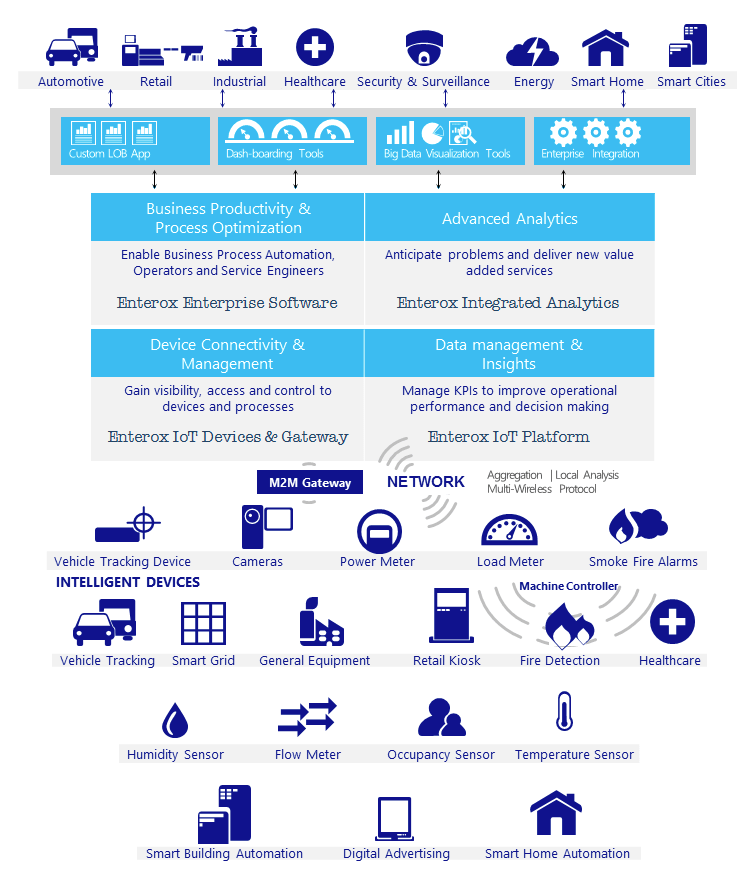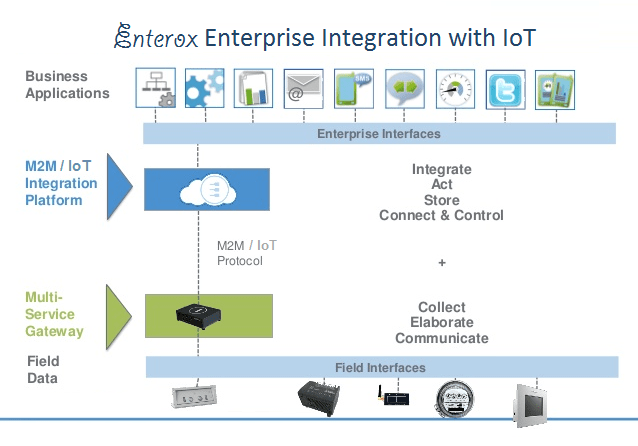Enterprise IoT

Enterprise Internet of Things
Enterprise Internet of Things is the next advancement in technology that enables physical 'things' with embedded computing devices (tiny computers) to participate in business processes for reducing manual work and increasing overall business efficiency. Taking advantage of a combination of technologies ranging from embedded devices with sensors and actuators to internet based communication and cloud platforms, the enterprise IoT applications can now automate business processes that depend on contextual information provided by programmed devices such as machines, vehicles and other equipments. Further such enterprise IoT applications can also send control instructions to these devices based on specific business rules. The Internet of Things, or IoT, is an exciting new concept, allowing previously unconnected physical devices to connect to the internet, the Internet of Things will ultimately become as fundamental as the Internet itself, with lots of opportunities and trials along the way.
Enterprise System and Internet of Things (IoT) will bridge diverse technologies to enable new business applications that connect with physical objects like devices and machines.
Enterprises have the capital, reach, resources and the right reasons to deploy IoT solutions and services on a large scale. They will see benefits from the IoT accrue fast enough to spur further adoption and investment.
The real value of enterprise IoT comes from data. With the advancements in Big Data processing and analysis, the insights derived from the IoT data sets will become invaluable for the enterprise decision makers. Technologies such as real-time stream analysis and machine learning enable compelling scenarios including predictive maintenance and proactive monitoring of expensive industrial equipment. Apart from mining the sensor data sets, connecting the legacy devices to software platforms and controlling them forms an essential element of an IoT solution.
Famark enables enterprises to leverage best–in–class IoT solutions, create IoT platforms for maximizing returns from their asset investments and create entirely new services that deliver measurable business values. Famark has been appreciated for its role and contribution in shaping the evolution of Industrial and Enterprise Internet of Things; particularly in establishing standards for communication between embedded IoT devices, IoT platform and enterprise software systems.
Enterprise IoT is anticipated to enhance enterprise efficiency, facilitate new business models, and align physical operations with digital assets on a real-time basis. Cloud and Big Data technology support Enterprise Internet of Things further as they provide scalability and intelligent insights. The goal is to generate insights, allowing for faster, accurate and appropriate decision making, and fostering a more customer centric business.
Overall, the real potential of Internet of Things (IoT) will be realized by the enterprise customers. Industrial IoT is turning into a multi-billion-dollar opportunity for platform vendors, hardware vendors, system integrators and emerging startups.
Enterprise Integration with IoT

Enterprise Integration with Internet of Things (IoT)
Enterprise integration is a general term for systems and services that serves to join together or mediate between two or more separate programs, applications, or machines. It is the use of technologies and services across an enterprise to enable the integration of software applications and hardware systems.
Enterprise Integration gives the ability to integrate the diverse data and information sourced from both within and outside enterprise into a single coherent framework. An integrated information infrastructure can then be shared by mission-critical applications in enterprise applications such as customer relationship management, executive information portals, dashboards, reporting systems and automated supply chain systems. Intercommunication between enterprise applications and Internet of Things enables an advanced level of automation that would require minimal manual intervention.
Enterprise Integration with IoT requires extending connectivity from enterprise and the cloud to devices at the edge of network. Famark IoT gateway resides between IoT devices that capture or generate data, such as sensors, and back-end applications that consume the data. Famark IoT Platform communicates via lightweight protocols including Zigbee and MQTT/TCP, or to sensor gateways via HTTP, allowing scalability and connectivity for managing and analyzing data from thousands of devices at the edge of network. Connecting all of the devices in distributed locations (e.g., retail stores, manufacturing or healthcare facilities), including servers, desktops, point-of-sale systems and kiosks to perform remote management.
Enterprise Architecture with Layers for IoT - The Eclipse Foundation’s IoT Working Group recently discussed this at length in the white paper, The Three Software Stacks Required for IoT Architectures. The IoT technology stack consists of three tiers: sensor devices, gateways, and the data center or cloud IoT platform. As explained in the paper, "a typical IoT solution is characterized by many devices (i.e., things) that may use some form of gateway to communicate through a network to an enterprise back-end server that is running an IoT platform that helps integrate the IoT information into the existing enterprise."
The device tier focuses on information gathering via sensors that can be embedded in many different types of devices, including mobile computing devices, wearable technology, and autonomous machines and appliances. They capture information about the physical environment, such as humidity, light, pressure, vibration and chemistry. Standards-based wired and wireless networking protocols are used to transmit the telemetry data going from the device through the gateway up to the cloud. It is typically telemetry data, but can also be command and control requests. On the other hand command and control data that goes from the cloud through the gateway, to the device.
The devices layer is the foundation of an IoT stack. Both legacy devices that existed for decades along with the modern, intelligent, and connected devices form the core. Each device is capable of acquiring data from a variety of sensors that track critical parameters. The devices can also be used to control the state of the equipment - For example, switching off a faulty machine or adjusting the RPM of a rotating gear. The devices layer provides the last mile connectivity to the remote equipment. It presents the current state of the devices along with the ability to remote control them.
The gateway, also referred to as the control tier, acts as an intermediary that facilitates communications, offloads processing functions and drives action. Because some sensors generate tens of thousands of data points per second, the gateway provides a place to preprocess the data locally before sending on to the cloud tier. When data is aggregated at the gateway, summarized and tactically analyzed, it can minimize the volume of unnecessary data forwarded on. Minimizing the amount of data can have a big impact on network transmission costs, especially over cellular networks. It also allows for critical business rules to be applied based on data coming in. The control tier is bidirectional. It can issue control information to the devices, such as configuration changes. At the same time, it can respond to data tier command-and-control requests, such as a security request for authentication.
Legacy devices and low power devices cannot directly register and communicate with the IoT platform. That’s where the gateway comes into the picture. Also known as the edge device, the gateway is responsible for acting as a proxy to the devices. It collects, aggregates, and optionally processes the data generated by the devices. The gateway can also accept and route commands sent from the backend to the respective device. Edge devices or local gateways present an enormous market opportunity. Hardware and networking vendors are eyeing to capture the market share by augmenting their routers, switches, firewalls and other edge devices that can double up as IoT gateways.
The combination of new IoT devices, legacy machinery, and edge devices forms the essential devices layer of the IoT stack.
The data center / cloud tier or IoT platform performs large-scale data computation to produce insights that generate business value. It offers the back-end business analytics to execute complex event processing, such as analyzing the data to create and adapt business rules based on historical trends, and then disseminates the business rules downstream. It needs to scale both horizontally - to support an ever growing number of connected devices, as well as vertically - to address a variety of different IoT solutions. Core functions of an IoT data center/cloud platform include connectivity and message routing, device management, data storage, event processing and analysis, and application integration and enablement.
The functional capabilities of enterprise IoT lies in the software platform that manages the devices, stores the data, analyzes it, and presents the insights to the decision makers. It acts as the middleware that orchestrates the entire workflow. Given the attributes of cloud such as elasticity, reliability, and scale, it is becoming the preferred deployment environment of IoT platforms.
The devices layer talks to the cloud gateway that is responsible for authenticating and authorizing the devices to participate in the workflow. It ensures secure communication between the devices and the centralized command center. The gateway is capable of dealing with multiple protocols and data formats. Heterogeneous devices and local gateways with disparate protocols seamlessly register with the cloud gateway. For example, devices and local gateways can talk to the cloud gateway through SOAP, REST, AMQP, XMPP, CoAP, MQTT, and Web Sockets. Irrespective of the inbound protocol, the cloud gateway presents a consistent view of the devices layer to the rest of the components.
A typical industrial IoT deployment deals with tens of thousands of sensors and devices deployed across multiple sites. Each device needs to be registered and maintained in a central repository, which acts as an authoritative inventory representing the current state of deployment. The device registry acts as central inventory where every device is registered with the system. Each device along with its metadata would be readily available in the registry. Any platform component can query the device registry to read the current state of the device along with its capability.
In conclusion, innovations in hardware systems like Arduinet and Raspberry Pi, are making it easier, faster and cheaper to develop new devices. Networking standards for low power networks, like LoRaWAN or Sigfox, create new opportunities for connecting very small devices to a network. New standards are being developed specifically for IoT use cases, like MQTT for messaging, or OMA Lightweight M2M for device management. And finally, significant improvements in enterprise system, data storage, data analysis, and event processing are making it possible to support the deployment of IoT in enterprises that help in increasing business efficiency.
Join Famark Community!
Famark community is a social platform for creative and innovative professionals from different domains.
Join Community